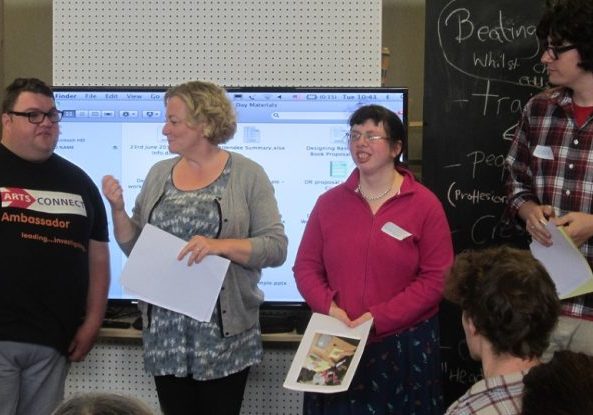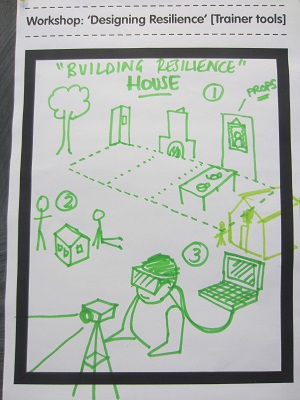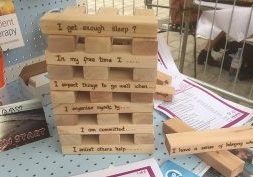Boingboing blogs from… Connected Communities Festival
Connected Communities Festival 2015: Designing Resilience – Bringing the Resilience Framework to Life!
by Ceri Davies – Development Manager, Community University Partnership Programme, University of Brighton
Bringing different people together, with different skills, interests, knowledge and experience is my day job. Often there are two or three, sometimes a few more and all of them are interested in the same topic – say social isolation. A few weeks ago, I found myself in a room with 30 people, university students, academics, creative professionals, parents, community groups, young people, artists (I’m sure I’ve left some off the list here). Together we were looking at the Resilience Framework (RF), and seeing in what different ways we could ‘bring it to life’. This event was part of the Arts and Humanities Council (AHRC) Connected Communities Festival 2015. The key goal of the day was to co-design ‘things’ that could be made and taken away to be used in resilience training sessions. So, not only were we trying to do that between all of us, but we were also seeing if we could do it by combining knowledge and enthusiasm for resilience and how it can be shared and used in everyday life, with knowledge and enthusiasm for design and creative processes. We were all going to give up a day of our time to hear about some of the ways people thought the RF could be developed – and match that with realistic ways to make it happen.
So how did we all get here? This day was planned a while back – when a smaller number of people gathered to test out how and explore how ‘designing’ and ‘resilience’ could work together (you can see how we came up with our snappy title). At this session seven different themes were identified that people could do further work on. These were ideas that people in practice were using or wanted to use or develop and I talk about them a bit more below.
If you don’t fancy reading the rest of this blog right now – you can watch this awesome 2 minute video to get a feel of what we’ve been up to so far…!
http://www.youtube.com/watch?v=ZHrbg6ZjhJ4
So back to the big day (with tea, orange juice and cake)… Angie Hart started us all off by helping us find out who was in the room. She asked us all to use language that everyone could understand as we had lots of different people in the room, and some of us had learning difficulties. Some people who worked with arts approaches professionally wanted to be ‘called creatives’. We agreed that most people in the room could call themselves ‘creatives’ if they wanted. It was quite hard deciding what to call everyone! Angie then went on to outline what we meant by resilience and how the framework had been developed. We agreed that it would be good to come up with new ideas about how we could help people to learn about resilience in more exciting ways.
Nick Gant, Assistant Head of School – Art, Design & Media at the University of Brighton then introduced what would happen next. We were going to hear about four of the themes in the morning, and three more in the afternoon. Each theme would have a ‘proposer’ who would spend five minutes outlining their ideas. After we had heard all 4, we would go into groups, with a mixture of other people to discuss them.
Victoria Jackson, a lecturer from the Art, Design & Media department at the University of Brighton then outlined the process we would use to think about the 7 themes. The ‘6 hat’ (external link) thinking process was used. An hour was given to go through the ‘6 hat’ process in the morning session and again in the afternoon session.
I’ll just give you an example of one of these themes in detail – the Suns & Clouds Game. Anne Rathbone, a PhD student at the University of Brighton and part of the Connected Communities Imagine Programme (external link), and Mikey Reynolds and Laura McGowan from Arts Connect (external link) introduced this theme with Connel Mclaughlin, a Fine Arts student who has been working with the group.
When the people from Arts Connect were playing the snakes and ladders game they thought that this was great and then they thought about developing their own version of the game called Suns and Clouds. The suns are good for you and the clouds are bad. The group wanted to make a big floor game that they could take around to different places and show people so that they could learn about resilience as they played the game. They thought that basing it on a journey through life would be good.
The clouds would relate to challenges that the people had experienced in their life and they could then play a resilient card to tackle this adversity. The resilience cards would be based on the framework. Pictures of suns and clouds have been produced by Arts Connect and they are in the process of thinking about and writing the resilient cards. The group asked people to think about how the game could be produced so that it was lightweight and easy to transport. A video clip of the Suns and Clouds theme can be viewed here:
The other themes were:
Talking Heads – using apps that allow you to imagine something from someone else’s perspective.
Photovoice – this is a process where someone takes a series of images that mean something to them, and then present them and reflect on them. This could be a way to think about and empower people to use resilience ideas.
Badges – designing badges that can represent ideas of resilience. It would be nice to give these to each other and they can be used as prompts for people to remember and hold on to ideas about the resilience framework.
Everyone in the room was asked to think about which ‘theme team’ they wanted to be part of, and then we sat in these teams – used the ‘different hats’ technique and got into discussions! This process was repeated in the afternoon for a further three themes. These were:
Resilience Tree – drawing ideas about resilience on leaves to create a whole picture.
Resilience House (this may ring a bell if you saw our blog about going to Cardiff last year…) – a physical space with different ‘rooms’ representing different parts of the resilience framework.
One Step Forward Book – this was a book developed to help people have conversation with young people in the care system, it would be good to find ways to bring it to life/include more exercises.
Phew! What a lot to get through! And everybody worked hard all day to explore the ideas and come up with realistic and do-able next steps. After the morning and afternoon session in ‘theme teams’ we came back together as a group to report on what ideas we’d come up with. People then volunteered to work together on an ‘action plan’ for their theme to try to develop a tool or output that can be showcased at an event in Brighton on 6th November. This will be a great opportunity to show others how we have worked together and co-designed new tools and ideas for bringing resilience to life (and everyone needs a deadline!).
It’s a really innovative approach to be bringing together such a wide range of people to work in this way. It challenges all of us to make ourselves and our ideas understood and benefit from someone else’s perspective. I’ll be taking some of that learning back to my day job! And look forward to seeing where this exciting project – and energy and commitment, go next.
*Thanks to Scott Dennis from Boingboing for sharing his notes and pictures of the day, some of which I included here*


